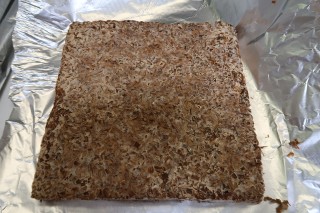
Model of Roggersdorf Church.
In the project "Climate for Culture" the influence of climate change on cultural assets in Europe is determined with 27 partners.
more info
Model of Roggersdorf Church.
In the project "Climate for Culture" the influence of climate change on cultural assets in Europe is determined with 27 partners.
more info
Fungal adhesive prototype made from cattail (lat. Typha) bound by the Ganoderma fungus.
To achieve a biological transformation, material flows must be considered as a whole and biointelligent solutions found for them. Closed material cycles are essential. For the insulating material, biological raw materials as well as residual materials are bonded together by mycelial growth.
more info
Green roofs increase the proportion of unsealed land in urban areas. Rainwater can seep into them and is stored instead of running off mostly as surface water.
In this project, the existing range of test facilities and simulation options at Fraunhofer IBP are supplemented in order to record rainwater retention capacity of green roofing structures.
more info
The structure of cattails makes them ideal for use in building materials.
Development and utilization of an innovative organic-based building material made of cattail and geopolymer.
more info
Individual modular elements.
There is a lack of suitable depots that meet the requirements of sustainability and energy efficiency as well as those of conservation.
more info
Sanssouci Palace Park - input data for the PALM-4U simulation (left) and simulated heat load on a hot summer's day (right).
Cultural assets are critical socio-cultural infrastructures whose services contribute to Germany's economic development and competitiveness and promote the community. However, the increase in extreme weather events due to climate change poses a threat to these infrastructures, such as historic buildings & gardens and cultural landscapes. The BMBF-SiFo project “KERES” therefore studied future extreme weather events and their effects on our cultural heritage in Germany, and used models to examine these scenarios.
more info
In order to contend with extreme and imminent climate change, and to sustain cultural cohesion in the inhospitable environments that may result, we need to learn how to adapt and live with extremes by embracing climatically appropriate architecture and infrastructure. Combining the sciences and the arts, The Consortium for Climate-Adapted Architectural Heritage forecasts future climates in terms of geographically-based climate analogs – elucidating the future climate of any given location by identifying places that currently have the anticipated climate conditions – helping communities to adapt to climate change through preemptive modification of the built environment.
more infoThe agricultural cultivation of cattail (Latin: typha) as a raw material for industrial use has numerous ecological and economic advantages.

The leaves have a fiber-reinforced supporting tissue filled with a soft open-cell spongy mass, giving them outstanding structural strength and excellent insulating properties.
Building material from bulrushes is predestined for industrial use due to its enormous productivity. The Fraunhofer IBP shows the cultivation of typha.
more info
Visit to the outdoor test site at Fraunhofer IBP in Holzkirchen with project partners.
The rapid economic development in Vietnam has led to changes in lifestyles and needs, accompanied by novel materials, building typologies, constructions and supply systems. This is associated with a variety of building physics challenges, especially under the demanding climate conditions. The German-Vietnamese project "CAMaRSEC" addresses these challenges through the implementation and further development of energy-efficient, resource-efficient and sustainable building practices.
more info
-> no rain; red = cellulose fiber 1; yellow = cellulose fiber 2; green = cellulose fiber 3; gray = mineral wool fiber 1; blue = mineral wool fiber 2 Range of fluctuations reported by the Research Group Vol.: gray stripes = for mineral wool; green stripes = for cellulose fiber.
The installation of internal insulation is often the only way to improve thermal insulation in the renovation of old buildings.
more info